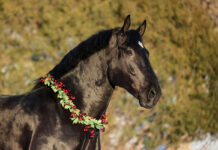The Curly Horse, also known as the American Bashkir Curly, North American Curly Horse and American Curly Horse, possesses not just beauty but brains, athleticism and a people-loving personality that makes the breed a great partner for a variety of equine endeavors.
Origins
In the U.S., it’s believed that Curly Horses were prized mounts of the Sioux and Crow. Some of the early foundation stock was discovered by ranchers in the early 20th century in Nevada, Wyoming and the Dakotas.

The Damele family of Nevada is one of the notable early breeders of the Curly Horse. They began capturing curly coated horses from the wild herd near Eureka in the 1930s to improve their ranch stock. Two especially harsh winters proved the hardiness of the horses with curly coats, so in the 1950s, the Dameles began breeding them in earnest.
General Appearance
Curlies average between 14 and 15 hands and 800 to 1,000 pounds, with outliers ranging from pony-sized to more than 16 hands. They generally have a strong, compact build, with a short back and one fewer vertebra (similar to the Arabian), as well as a flat croup, strong cannon bones and a well-muscled, medium-length neck. Their heads are often straight in profile with wide-set eyes that can tend toward being almond-shaped. Hooves are generally black and strong.

Their curly coats, which come in all standard solid colors as well as with spotted and pinto markings, are more prominent in the winter, with curls ranging from ringlets to dense waves to the look and feel of crushed velvet. Horses’ summer coats usually still have a wave pattern, even if it’s not as dramatic as the curls seen in winter. While some horses have more coat curliness than others, all Curly Horses have curly hair inside their ears and curly fetlocks.
It’s not uncommon for their curly manes and tails to thin in the summer—occasionally they shed out completely—and then grow back again during the year ahead.
It’s All in the Genes
Studies have discovered dominant curly coat genes in Mustangs and Native American horses found throughout North American wild herds, and recessive curly coat genes in various other breeds of horses.
Curly Horse breeders seek to breed for the dominant gene, as it is responsible for the desirable curly coat patterns. Foals that receive the correct genes to have a curly coat will be curly from birth.

Research continues into the genetics of the curly coat and isolating the dominant curly gene.
Hypoallergenic Properties
The Curly Horse’s coat (including the smooth coats found in the breed) has been shown to be hypoallergenic, which means low-allergy, not necessarily no-allergy. Still, studies—and many anecdotal reports—have shown that humans with allergies to normal horses can be around Curly Horses without enduring the symptoms of sneezing, itchy eyes and asthma that can occur in response to allergens.
Based on past studies, theories as to why Curly Horses are hypoallergenic range from their hair structure being round rather than flat to their having fewer allergy-producing proteins in their dander than regular horses.
Curly Characteristics

Curlies have a temperament that many aficionados describe as smart, brave and steady. In potentially dangerous situations, Curly Horses seem to reason instead of panic and stop instead of running or fighting. This can be a great benefit to beginners or youth riders.
From dressage and western dressage to eventing, endurance, jumping, driving, equine therapy and ranch work, the Curly Horse has standouts in every area. The United States Equestrian Federation lists nearly 30 Curly Horses competing in different divisions, most notably dressage and sport horse classes.
Curlies tend to have quick pulse and respiration recovery rates in response to exercise, and they have a can-do attitude with a trusted handler. In addition, they seem to handle new environments in stride without becoming overly stressed.
There are likely less than 10,000 Curly Horses in the U.S. when including the three main registries and curlies that are not registered with any group.
This article originally appeared in the November 2015 issue of Horse Illustrated magazine. Click here to subscribe!






Did’nt you know this studies:Allergy against horses: Are curly horses an alternative for horse allergic-riders? A pilot observational case study” W. Mitlehner, Allergojournal 2013;22,244-251
Horse Allergy: Curly Horses Allow Horse Allergic Riders To Ride Again – An Observational Study W. Mitlehner, H.C. Mitlehner, B. Niggemann, Pneumologie 2015;69(12):711-718. DOI:10.1055/S-0034-1393396
Curlies come in miniature too! You can find them by googling, and there are several curly mini/pony FB sites.
I am a Curly breeder. interested in genetic data.
Jerry Halvorson